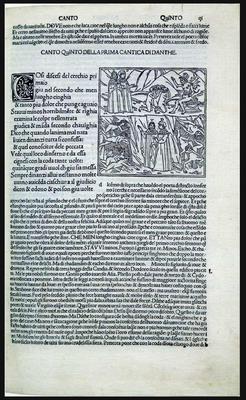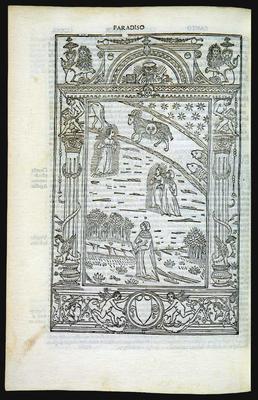Dante Alighieri
Comento di christophoro Landino fiorentino sopra la comedia di Danthe alighieri poeta fiorentino.
Venice, Petrus de Plasiis, 18 November 1491.Folio (296 x 196 mm). Collation: a10 [fol. a10r blank)], AA4, B-Z8, a-q8, r6 (in the present copy the four-leaf quire AA, containing on two columns the Tabula di Danthe, is bound between the quires A and B). [14], 317 (i.e. 307), [3]. Text surrounded by commentary, 44-61 lines. Type: 6:109R, 7:80R. The text of Dante's Canzoni on three columns. Three full-page woodcuts, the first one showing Dante, Virgil and the three wild beasts (fol. a1v); ninety-seven woodcut small vignettes. Numerous woodcut decorated initials on black ground, 9-line initials at the beginning of each cantica. Blank spaces for capitals, with printed guided letters. Some vignettes and initials with partial contemporary red colouring.Twentieth-century brown leather, blind-tooled in antique style. Spine with four raised bands. Marbled pastedowns and flyleaves. A very fine copy, the upper margin of some leaves slightly short. A few light stains and sposts. A marginal note on fol. N3r.
This Venetian edition of the Commedia, accompanied by the commentary of Cristoforo Landino and published by Pietro Piasi from Cremona, contains in the last leaves the first appearance in print of Dante's Canzoni, apart from three canzoni which had already been published in the first edition of the Convivio, printed in Florence in 1490. The woodcuts illustrating the volume are very similar in style and quality to those in popular style used by Bernardinus Benali and Matteo Capcasa for the Commedia printed only a few months before, in March. The comparison between these Venetian woodcut series reveals however some variants, and the vignettes used by Piasi are generally larger.
The blocks, could be produced by a same Venetian workshop which could have supplied each printer with his own series of woodcuts.



